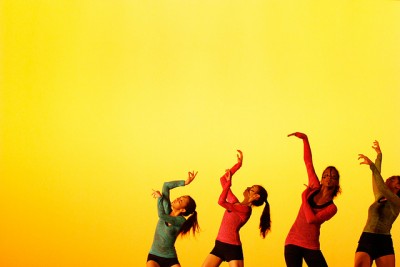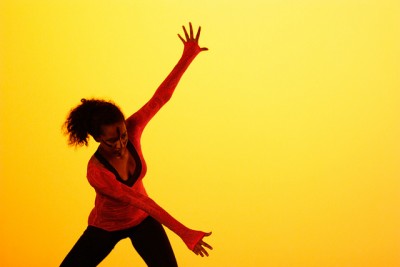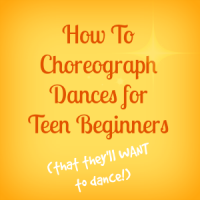A dancer’s first time on the dance recital stage can be terrifying, especially for a teen beginner but, if you teach dancers brave enough to set foot on stage with limited experience, you owe them a performance piece that allows them to shine.
Creating a recital dance that allows beginners a first-time performance experience can be especially challenging when working with teens—try some of the tips below to create a dance that everyone can be proud of.

The piece should make them –and you– look good!
Play to their strengths. Give them movement that they are comfortable doing – typically movement that is slightly easier than the material you are presenting them in class. Now is not the moment to show off how many unique progressions you can think of.
On stage, everything changes. People get nervous. Beginning dancers (yes, even teens) get confused about where the front is. Costumes malfunction. Clean and simple material that showcases what they do well helps your dancers to feel confident enough to deal with all the other unknowns, which is less headache for you, too.
Give them a gimmick
No one can resist a good gimmick. Get the audience to buy into your piece before your teens even start dancing. This could be as simple as choosing an extremely popular song with a well known music video and using some similar movements.
Consider using a prop to draw in the crowd. I’ve seen beginning classes use hoops, stretchy bands and ribbon wands to create interest and depth for dancers who aren’t comfortable stringing complex steps together. I used glowsticks for a teen beginning ballet piece. The audience loved it, and it raised the dancers’ confidence to have the audience applauding as soon as they entered the stage.
Dancers love to feel like they are a part of something unique and exciting, but teen beginners don’t have the technical vocabulary to follow out of the box choreography. Use something with a little schtick to draw them in.

Get dancer buy-in
Teen beginners are taking a big risk, so I consider their likes, dislikes, and get their input.
I often ask my dancers to brainstorm what they would love to do in a recital piece. I ask for costume ideas, music choices and general themes. I also ask them to let me know (privately if they want) what they would be embarrassed to wear. If wearing a leotard and tights will cause them major anxiety, choose a different costume.
I use a lot of instrumental arrangements of popular songs for my teen beginning ballet dancers, and songs from well known musicals for those just starting out in Jazz. If they can get excited about their performance, and can relate to what they are dancing, they are more likely to feel comfortable onstage.
Repeat, repeat, repeat
Do not a fear a great repetitive phrase. This will not only give dancers a lifeboat if they get lost in the choreography, but will tie your piece together and give the audience something to expect. Using repetitive footwork also allows you to be more creative with your staging and movement. You can have your dancers repeat the phrase facing different ways, in different formations, and with different arms to keep it from getting boring.
Most of the audience will be excited to see first-time teen dancers on stage at all, much less moving in unison with each other. There is no reason to get too fancy.
Start Early
It’s never too early to start planning your recital dances but, if you aren’t ready to introduce your song and all its trappings to your dancers early, don’t worry. Plan a phrase or specific steps you’d like to use in your choreography and start using them in class. Put that awesome leap progression your kids have been working on into their recital dance. Take the combination they do in their warm up, add some arms and use it.
 Your dancers will thank you for using material with which they are comfortable when they step onstage, and will be impressed with your forethought. No beginning dancer has every said she was over-prepared for her performance. Feel free to start months in advance.
Your dancers will thank you for using material with which they are comfortable when they step onstage, and will be impressed with your forethought. No beginning dancer has every said she was over-prepared for her performance. Feel free to start months in advance.
Teen beginning dancers don’t always feel super-comfortable in their skin. They are more worried than other age-groups about what they will look like in front of all those people, and the recital experience is unknown to them. Giving your teen beginners something they are confident in, comfortable doing and excited about performing, not to mention the opportunity to succeed at something that takes courage, is a gift for which they’ll be thanking you for years to come.
Carlye Cunniff is a professional dancer and dance educator based in Seattle, Washington. She currently co-directs and dances in the Seattle Irish Dance Company, teaches all around the city and writes about all things dance.

Dance Advantage welcomes guest posts from other dance teachers, students, parents, professionals, or those knowledgeable in related fields. If you are interested in having your article published at Dance Advantage, please see the following info on submitting a guest post. Read posts from guest contributors.

